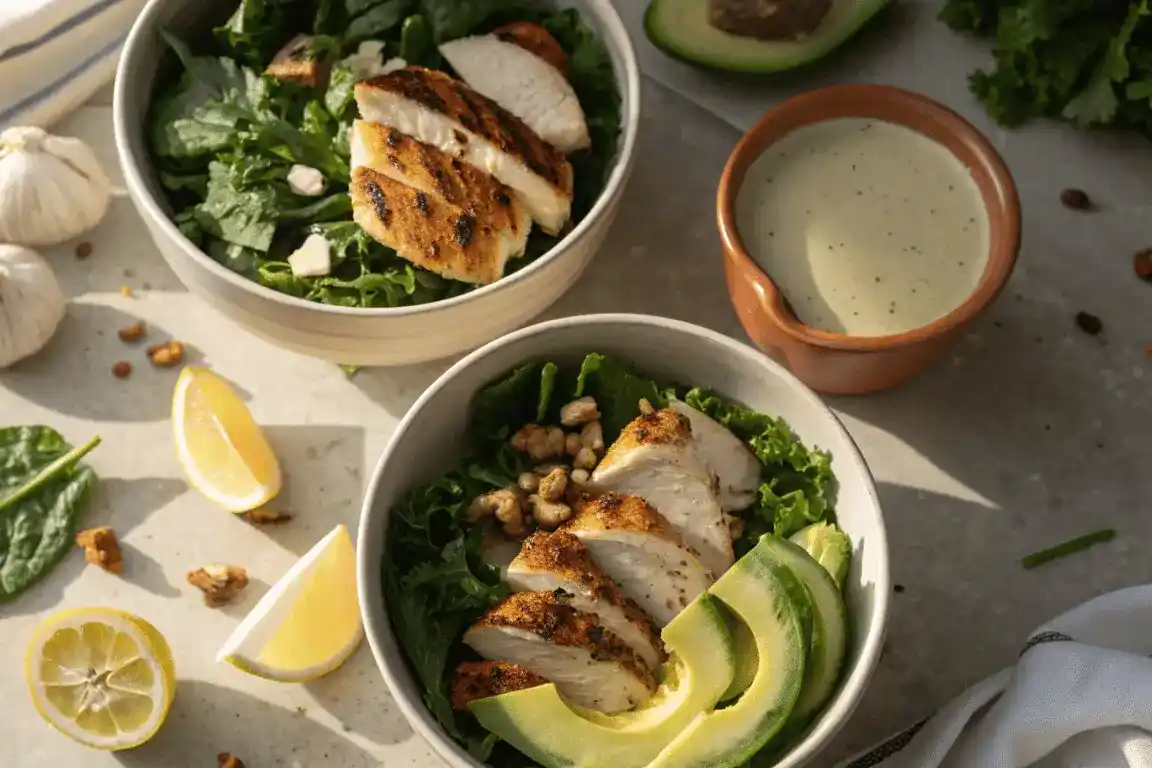Many people experience bloating, fatigue, and brain fog without realizing that Candida overgrowth might be disrupting their gut health. Diet plays a critical role in either fueling that imbalance or reversing it. This guide presents a curated collection of Candida-friendly recipes that are practical, flavorful, and designed to support a natural path to gut healing.
Created through extensive research and real-world application, these meals focus on clean ingredients, anti-fungal nutrients, and digestive support. From energizing breakfasts to hearty dinners and nourishing snacks, each recipe avoids common triggers like sugar, yeast, and processed carbs.
This article is crafted for individuals seeking a gentle, food-based approach to reduce Candida, restore gut balance, and improve overall wellness. Whether just starting a Candida cleanse or refining an anti-inflammatory routine, these recipes are meant to simplify healthy eating without sacrificing taste or satisfaction.
Before jumping into the recipes, the first section explains what Candida is and how it affects the gut. The goal is to empower informed choices for those who want to eat with purpose and heal naturally.
Table of Contents
Understanding Candida and Gut Health
What Is Candida Overgrowth and How It Affects Your Gut
Candida is a yeast that normally lives in harmony with other microorganisms in your mouth, gut, and on your skin. In small amounts, it plays a neutral or even helpful role. However, when Candida begins to multiply beyond healthy levels, it leads to what is known as Candida overgrowth, which can disrupt the balance of bacteria in your digestive system and create various health issues.
Some common symptoms of Candida overgrowth include:
| Symptom | Common Triggers |
|---|---|
| Bloating and gas | Diets high in sugar |
| Chronic fatigue or foggy thinking | Antibiotic overuse |
| Cravings for sweets | Processed food consumption |
| Recurring yeast infections | Weakened immune system |
When Candida becomes excessive, it can compromise the gut lining, causing what many refer to as “leaky gut.” This condition allows undigested food particles, toxins, and pathogens to enter the bloodstream, potentially triggering autoimmune responses, allergies, skin conditions, and inflammation throughout the body.
Why Diet Plays a Critical Role in Managing Candida Naturally
A healthy gut requires balance, and that balance starts with the foods you eat. Candida thrives on sugar and refined carbohydrates. If your diet is rich in these, it creates the perfect environment for yeast to flourish. Shifting to Candida-friendly recipes helps eliminate the yeast’s food source while strengthening your digestive and immune systems.
A Candida-friendly diet focuses on the following:
- Non-starchy vegetables like spinach, zucchini, and broccoli
- Lean proteins including eggs, poultry, and wild-caught fish
- Healthy fats such as olive oil, coconut oil, and avocado
- Fermented foods like sauerkraut and kefir
- Antifungal herbs and spices including garlic, oregano, and turmeric
These foods not only help starve out the overgrown yeast but also support the growth of beneficial gut bacteria. This dual approach encourages a healthy microbiome and prevents recurring Candida problems.
Integrating Candida-friendly meals into your daily routine can lead to more energy, improved digestion, and clearer thinking. With the right guidance and recipes, healing your gut becomes both manageable and enjoyable.
Candida-Friendly Breakfast Recipes
Starting your day with the right foods is one of the most powerful ways to manage Candida overgrowth. Breakfast is your first opportunity to fuel your body with clean energy, support your gut, and avoid the sugar spikes that feed unwanted yeast. These Candida-friendly breakfast recipes are low in carbs and sugar, rich in protein and healthy fats, and easy to prepare even on busy mornings.
Kefir Smoothie with Berries and Almond Butter
Fermented foods are an essential part of any anti-Candida meal plan. Unsweetened kefir is loaded with probiotics that support a healthy gut and help keep Candida under control. When paired with antioxidant-rich berries and almond butter, it makes for a creamy and satisfying breakfast.
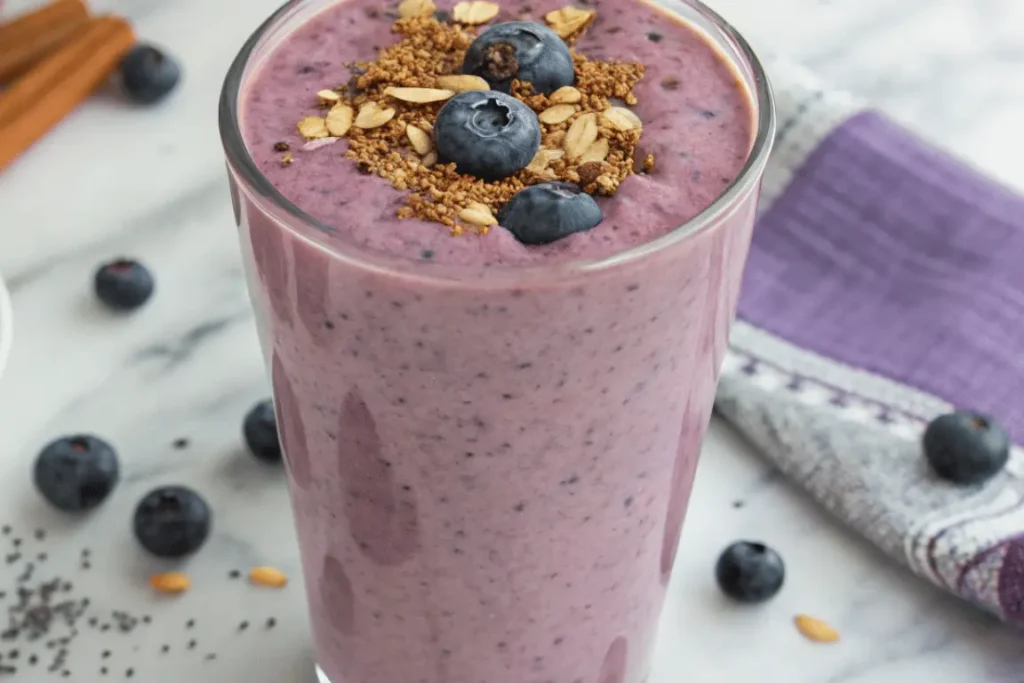
Ingredients:
- 1 cup unsweetened coconut or goat milk kefir
- ½ cup frozen organic blueberries or raspberries
- 1 tablespoon unsweetened almond butter
- ½ teaspoon cinnamon
- 1 scoop of collagen or plant-based protein (optional)
- Handful of ice
Instructions:
- Blend all ingredients until smooth.
- Serve immediately for a refreshing and gut-boosting start to your day.
The natural tartness of kefir balances well with berries, and the almond butter adds a dose of healthy fat to keep you full longer. Cinnamon offers antifungal benefits and helps regulate blood sugar levels.
Looking for inspiration? Try our Sugar-Free Smoothie Collection, simple raw vegan recipes.
Buckwheat Pancakes with Coconut Yogurt
Although the word “wheat” is in the name, buckwheat is completely gluten-free and safe for those on a Candida diet. These pancakes are hearty, delicious, and topped with coconut yogurt for an added probiotic punch.
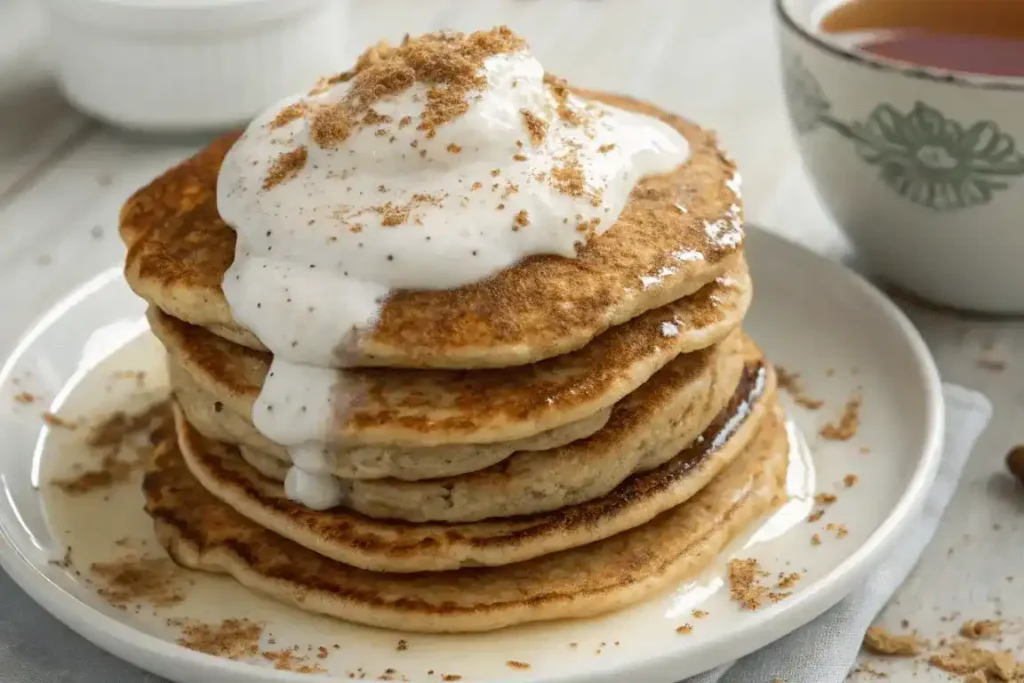
Ingredients:
- 1 cup buckwheat flour
- 1 egg
- ¾ cup unsweetened almond milk
- 1 teaspoon baking soda (aluminum-free)
- Pinch of sea salt
- 1 tablespoon coconut oil (for cooking)
- Coconut yogurt (unsweetened) for topping
Instructions:
- Mix flour, egg, almond milk, baking soda, and salt in a bowl.
- Heat coconut oil in a skillet. Pour batter in small rounds.
- Cook on both sides until golden brown.
- Serve with a dollop of unsweetened coconut yogurt.
These pancakes are fiber-rich and keep blood sugar stable. They pair perfectly with herbal tea or lemon water to support digestion.
Egg Scramble with Spinach and Avocado
Eggs are an excellent source of protein and healthy fats, both of which are essential when managing Candida through food. This quick scramble provides nutrients that boost your energy and support gut repair.
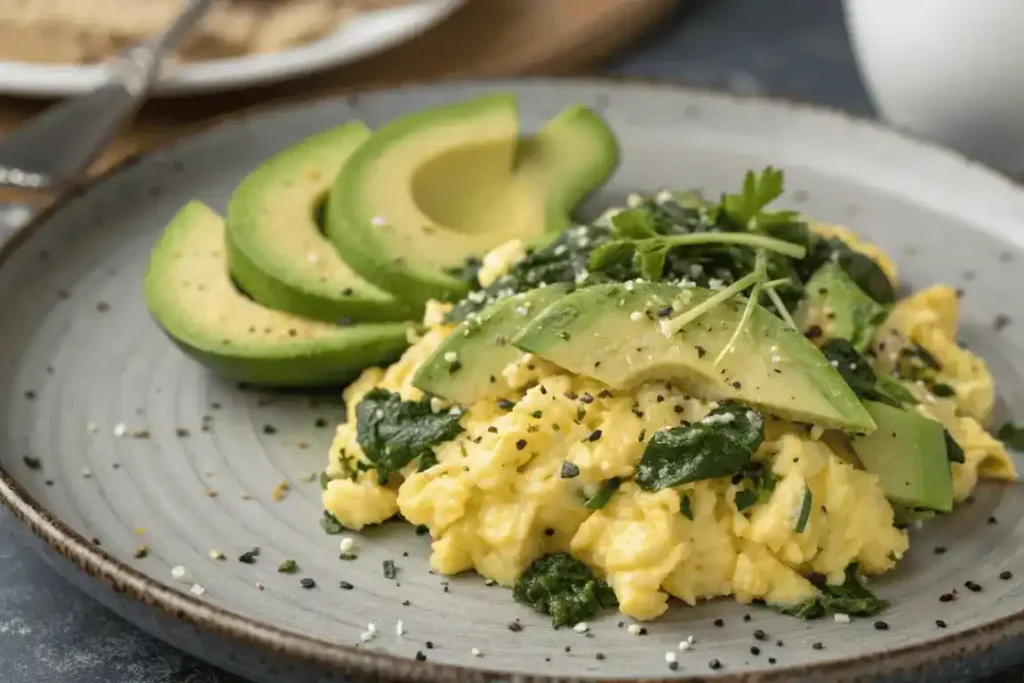
Ingredients:
- 2 organic eggs
- ½ cup chopped spinach
- 1 tablespoon olive oil
- ½ avocado, sliced
- Pinch of Himalayan salt
- Black pepper to taste
Instructions:
- In a skillet, heat olive oil and sauté spinach for 1 minute.
- Add beaten eggs and cook gently, stirring until scrambled.
- Serve with avocado slices on top.
The combination of leafy greens, eggs, and avocado delivers a full spectrum of vitamins, minerals, and gut-friendly fats. Spinach is high in magnesium, which helps the digestive system function efficiently.
By starting your morning with one of these Candida-friendly breakfast recipes, you create a strong foundation for stable energy and balanced digestion throughout the day. These meals are not only healing but also enjoyable, making your wellness journey feel rewarding and sustainable.
Gut-Healing Candida Lunch Recipes
Lunch is a crucial part of your Candida meal plan. By mid-day, your body needs a steady supply of energy to maintain focus, stabilize blood sugar, and continue supporting gut health. These Candida-friendly lunch recipes are packed with protein, fiber, and anti-inflammatory ingredients that nourish your digestive system and keep Candida overgrowth in check.
Chef Salad with Olive Oil Dressing
A classic chef salad can be an ideal Candida-friendly lunch when made with clean proteins and a healthy homemade dressing. Skip processed deli meats and opt for grilled chicken, boiled eggs, and plenty of fresh vegetables.
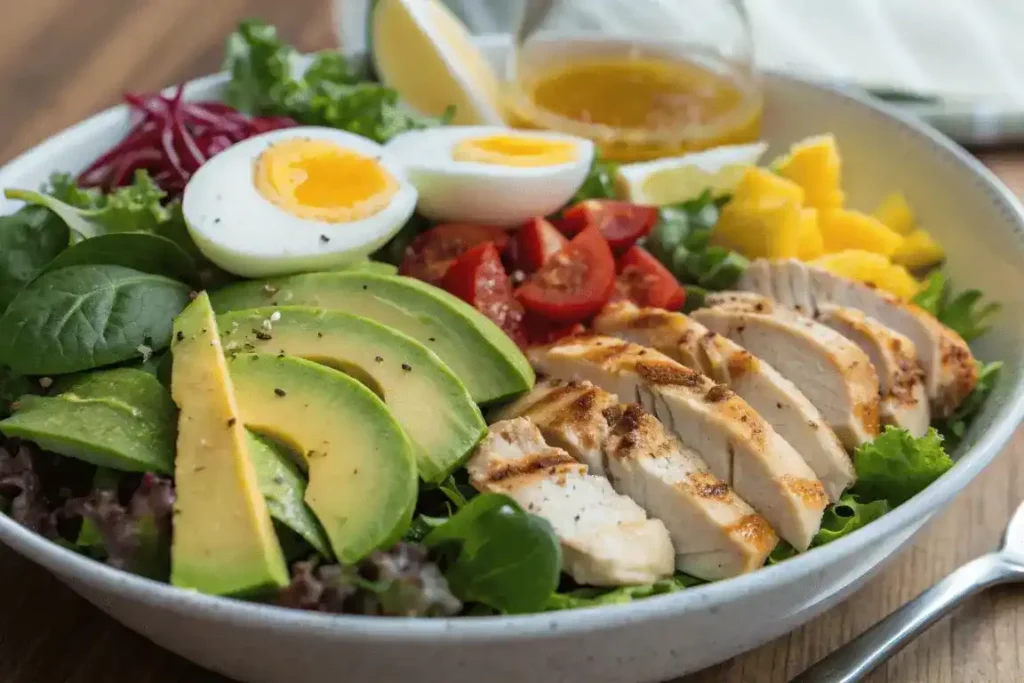
Ingredients:
- 2 cups mixed leafy greens
- ½ cup chopped cucumbers
- ½ cup cherry tomatoes (optional, in small amounts)
- 1 boiled egg, sliced
- ½ avocado, sliced
- ½ cup grilled chicken breast
- Dressing: 2 tablespoons olive oil, 1 teaspoon apple cider vinegar, pinch of sea salt, black pepper
Instructions:
- Combine all vegetables and protein in a large bowl.
- Whisk together dressing ingredients and drizzle over the salad.
- Toss gently before serving.
This nutrient-rich salad is low in carbs and free from additives that feed yeast. Olive oil provides healthy fats, while apple cider vinegar supports digestion and has antifungal properties.
Chicken or Tofu Stir-Fry with Cauliflower Rice
A stir-fry makes a quick, satisfying lunch that keeps you full and energized throughout the afternoon. Cauliflower rice is an excellent grain-free substitute that fits perfectly into Candida-friendly recipes.
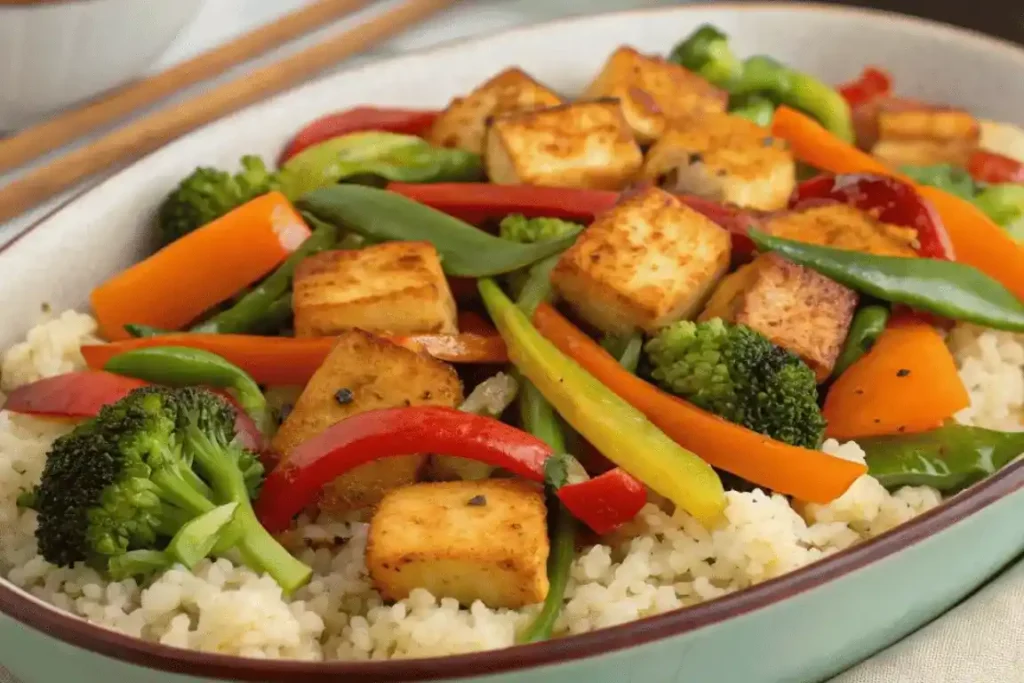
Ingredients:
- 1 cup cauliflower rice
- ½ cup sliced zucchini
- ½ cup sliced bell peppers
- ½ cup grilled chicken or tofu
- 1 tablespoon coconut oil
- 1 clove garlic, minced
- 1 tablespoon coconut aminos (soy-free alternative)
- Pinch of ginger and sea salt
Instructions:
- In a skillet, heat coconut oil and sauté garlic and vegetables.
- Add chicken or tofu and stir until heated through.
- Mix in cauliflower rice and seasonings, cooking for another 5 minutes.
- Serve warm.
This dish is full of flavor without the use of grains or sauces that may contain hidden sugars. Garlic and ginger also act as natural antifungal agents, which makes this stir-fry ideal for fighting Candida.
Quinoa Salad with Grilled Chicken and Roasted Vegetables
While most grains are discouraged during a Candida cleanse, some people tolerate small portions of cooked quinoa, which is gluten-free and high in protein. This salad is colorful, satisfying, and easy to make in advance.
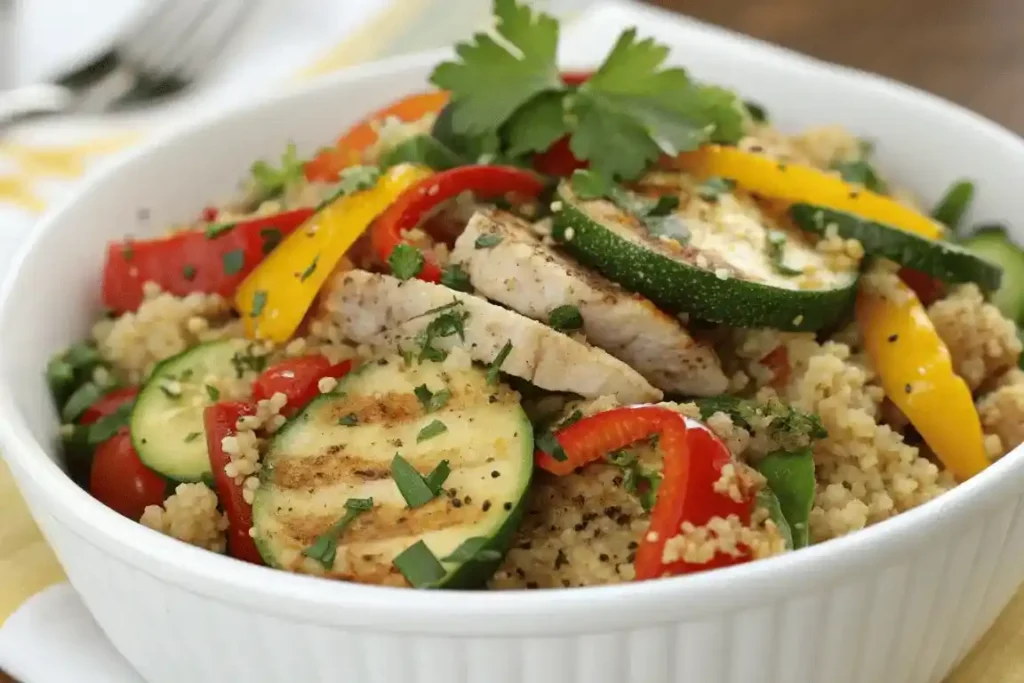
Ingredients:
- ½ cup cooked quinoa
- ½ cup grilled chicken
- ½ cup roasted vegetables (zucchini, carrots, bell peppers)
- 1 tablespoon olive oil
- 1 teaspoon lemon juice
- Fresh parsley and basil for garnish
Instructions:
- Toss quinoa, chicken, and vegetables in a bowl.
- Drizzle with olive oil and lemon juice.
- Add fresh herbs and mix gently.
This meal is ideal for meal prep and can be eaten cold or slightly warmed. Roasted vegetables provide natural sweetness without spiking blood sugar, and olive oil helps the body absorb fat-soluble vitamins.
A well-balanced Candida-friendly lunch supports stable energy and digestion, helping you avoid the afternoon crash. With options like salads, stir-fries, and quinoa bowls, you will never feel deprived while staying on track with your gut healing goals.
Candida Diet-Friendly Dinner Recipes
Dinner is your chance to end the day with a nourishing, low-sugar meal that supports digestion, reduces inflammation, and prepares your body for overnight repair. These Candida-friendly dinner recipes focus on clean proteins, non-starchy vegetables, and anti-fungal ingredients that promote gut balance and help reduce yeast overgrowth without sacrificing taste or satisfaction.
Chicken Fajita Bowl with Fresh Veggies and Avocado
This grain-free fajita bowl brings all the bold flavors of Tex-Mex cuisine in a Candida-safe format. It replaces tortillas with sautéed vegetables and skips any added sugars or heavy sauces that could disrupt your progress.
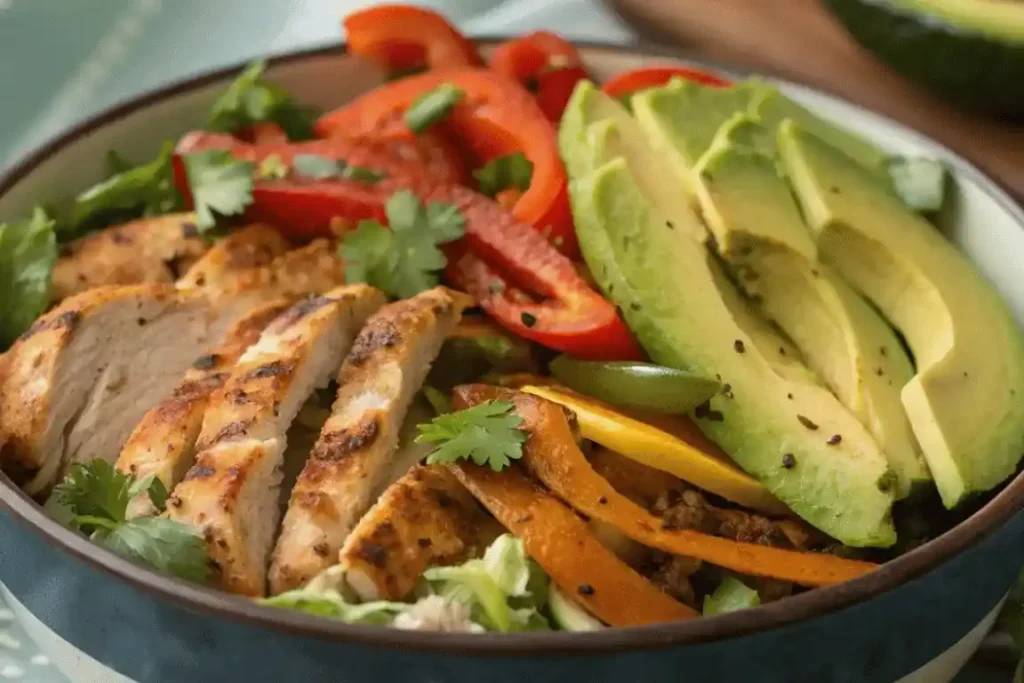
Ingredients:
- 1 grilled chicken breast, sliced
- ½ cup sliced bell peppers
- ½ cup sliced onions
- 1 tablespoon olive oil
- ½ avocado, diced
- Fresh cilantro and lime juice for garnish
- Pinch of sea salt, black pepper, cumin, and paprika
Instructions:
- Heat olive oil in a skillet and sauté onions and peppers until soft.
- Add grilled chicken and seasonings, cooking until warm.
- Serve in a bowl topped with avocado, lime juice, and fresh cilantro.
This dinner provides high-quality protein, healthy fats, and fiber-rich vegetables. The spices used here also help support the body’s natural defenses against Candida overgrowth.
Zucchini Noodles with Chicken and Homemade Pesto
Zucchini noodles are a fantastic low-carb alternative to pasta and pair perfectly with grilled chicken and a dairy-free pesto made with olive oil, basil, and garlic. This meal is light yet filling, perfect for evenings when you want something comforting without the carbs.
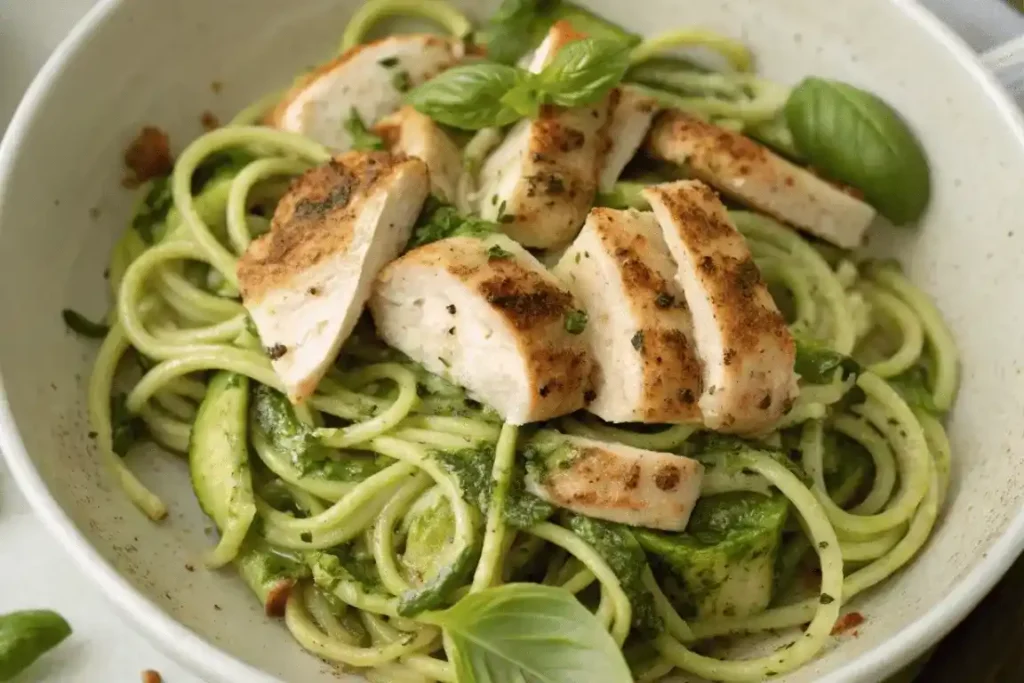
Ingredients:
- 1 medium zucchini, spiralized
- ½ cup cooked chicken breast, shredded or chopped
- 2 tablespoons dairy-free pesto (basil, olive oil, garlic, nutritional yeast)
- 1 tablespoon olive oil
- Sea salt and cracked pepper to taste
Instructions:
- Heat olive oil in a pan and lightly sauté the zucchini noodles for 2 to 3 minutes.
- Add chicken and pesto and stir gently until warm.
- Serve with a sprinkle of cracked pepper and fresh herbs.
This dinner is quick to prepare and packed with flavor. Garlic in the pesto has natural antifungal properties, while zucchini is easy to digest and low in sugar.
Cauliflower Curry with Anti-Inflammatory Spices
A warm vegetable curry made with cauliflower, coconut milk, and healing spices can be both comforting and beneficial to gut health. This dish is rich in fiber and flavor and free of ingredients that encourage yeast overgrowth.

Ingredients:
- 1½ cups cauliflower florets
- ½ cup chopped spinach
- 1 cup unsweetened coconut milk
- 1 tablespoon coconut oil
- 1 clove garlic, minced
- ½ teaspoon turmeric
- ½ teaspoon cumin
- Sea salt to taste
Instructions:
- In a saucepan, heat coconut oil and sauté garlic until fragrant.
- Add cauliflower and spinach and stir for 3 to 4 minutes.
- Pour in coconut milk, spices, and salt, then simmer for 10 minutes.
- Serve hot, optionally topped with fresh parsley.
This curry helps calm inflammation in the gut and keeps meals satisfying without the use of grains or sugars. The turmeric and garlic support detoxification and immune health while providing depth of flavor.
Eating a clean, nutrient-dense dinner each night not only supports restful sleep but also allows your body to heal and rebuild. These Candida-friendly recipes prove that dinner can be both healing and enjoyable when made with the right ingredients.
Clean Candida-Friendly Snack Options
When hunger strikes between meals, having clean, Candida-friendly snacks on hand can prevent you from reaching for something that could feed yeast and undo your progress. Smart snacking plays an important role in maintaining energy levels, keeping blood sugar stable, and supporting your gut’s healing process. These simple snack ideas fit perfectly into a Candida-friendly lifestyle and are easy to prepare at home or take on the go.
Hummus with Carrot and Celery Sticks
Hummus made from soaked chickpeas, olive oil, and tahini can be a satisfying and nutritious snack when paired with raw vegetables. Carrots and celery provide crunch without spiking blood sugar, making this combo both satisfying and gut-friendly.

Ingredients:
- ½ cup homemade or clean-label hummus (check for no added sugars or preservatives)
- 1 cup raw carrot and celery sticks
- Sprinkle of paprika or cumin (optional)
- Pinch of sea salt
Instructions:
- Wash and cut the carrots and celery into dipping-sized sticks.
- Portion out the hummus and sprinkle with spices if desired.
- Enjoy immediately or pack for later in a sealed container.
This snack offers fiber, plant-based protein, and healthy fats that work together to support digestion and immunity. Olive oil in hummus also adds a dose of anti-inflammatory benefits.
Hard-Boiled Eggs for Protein-Packed Snacking
Hard-boiled eggs are one of the easiest snacks to prepare in advance. They are rich in protein, contain essential amino acids, and help keep you full without affecting blood sugar. This makes them ideal for individuals avoiding sugar and grains.
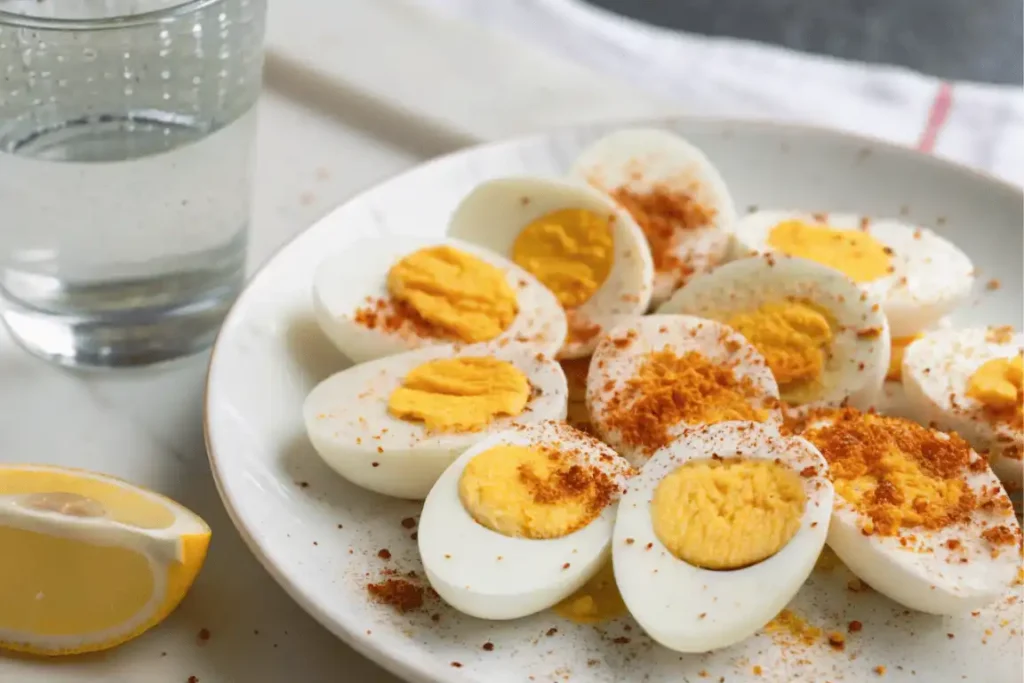
Ingredients:
- 2 organic eggs
- Sea salt and cracked pepper
- Optional: sprinkle of turmeric or paprika for extra flavor
Instructions:
- Boil eggs for 10 minutes, then cool in ice water.
- Peel and store in the refrigerator for up to five days.
- Slice in half and season before eating.
Hard-boiled eggs are portable, convenient, and provide a steady source of energy. They also contain choline, which supports liver function and detoxification.
Bone Broth for Gut Lining Repair and Immunity
Bone broth is more than just a trend. It is rich in collagen, gelatin, and minerals that help heal the gut lining, especially for those dealing with leaky gut due to Candida overgrowth. Sipping warm broth between meals can also soothe digestion and reduce inflammation.

Ingredients:
- 1 cup homemade or clean, organic store-bought bone broth (look for low-sodium and no additives)
- Pinch of sea salt
- Optional: sliced garlic or turmeric for added benefits
Instructions:
- Warm the broth gently in a small saucepan.
- Add any herbs or spices as desired.
- Pour into a mug and sip slowly.
Bone broth is an excellent way to hydrate while supporting the digestive tract. Its amino acid content helps repair tissue, while the minerals it provides contribute to electrolyte balance.
When cravings hit, reaching for the right snack can make a huge difference in your gut health journey. These Candida-friendly snacks are not only satisfying but also deliver nutrients your body needs to heal and thrive.
FAQs About Candida-Friendly Recipes and Gut Health
1. What food is the strongest Candida killer?
Garlic is often considered one of the most powerful natural Candida killers. It contains allicin, a compound with strong antifungal properties. Other effective options include coconut oil, which has caprylic acid, and oregano oil, known for its antifungal and antibacterial qualities. Foods rich in these natural compounds can help weaken the Candida cell walls and limit yeast overgrowth when used consistently in Candida-friendly recipes.
2. What kills Candida in the gut fast?
Combining an antifungal diet with specific natural agents can help speed up Candida elimination. Focus on eating non-starchy vegetables, healthy fats like olive oil and coconut oil, and lean proteins. Add in garlic, oregano, and apple cider vinegar to help reduce Candida activity. Consuming probiotic-rich foods like unsweetened kefir or sauerkraut can also help restore balance in the gut by increasing the population of beneficial bacteria that compete with Candida.
3. How do you flush Candida out of your body?
Flushing Candida from the body requires a combination of dietary changes, hydration, and liver support. Begin by removing sugar, alcohol, refined carbs, and processed foods from your meals. Drink plenty of water with fresh lemon to support detoxification. Include leafy greens, bone broth, and foods high in fiber to help move waste through the digestive tract. Herbal teas with dandelion root or milk thistle can support liver function, which is essential for removing toxins released by dying Candida cells.
4. Is peanut butter ok on a Candida diet?
Peanut butter is not recommended on a strict Candida diet. Peanuts are often contaminated with mold and aflatoxins, which can worsen yeast-related symptoms. They are also inflammatory for many people. If you want a similar texture or taste, try almond butter or sunflower seed butter, but choose varieties that are unsweetened and free from added oils or preservatives.
5. Does coffee feed Candida?
Coffee itself does not contain sugar, but it can be problematic for several reasons. First, it can cause spikes in blood sugar and stress hormones, which may create an environment where Candida thrives. Second, coffee often contains mold residues, which can trigger symptoms in sensitive individuals. If you do drink coffee, choose organic, mold-free brands and avoid adding dairy or sweeteners. Many people replace coffee with herbal teas or caffeine-free alternatives while on a Candida protocol.
Conclusion
Following a Candida-friendly diet does not mean giving up flavor or variety. By focusing on clean proteins, low-glycemic vegetables, healthy fats, and gut-supporting ingredients, you can enjoy delicious meals while healing your body from the inside out. From energizing smoothies to nourishing dinners and satisfying snacks, these Candida-friendly recipes give your gut the nutrients it needs to restore balance and reduce yeast overgrowth naturally.
Consistency is key. Prepare ahead, make smart substitutions, and avoid common triggers like hidden sugars and refined carbs. With the right tools and guidance, your journey toward better gut health becomes simpler and more sustainable.

